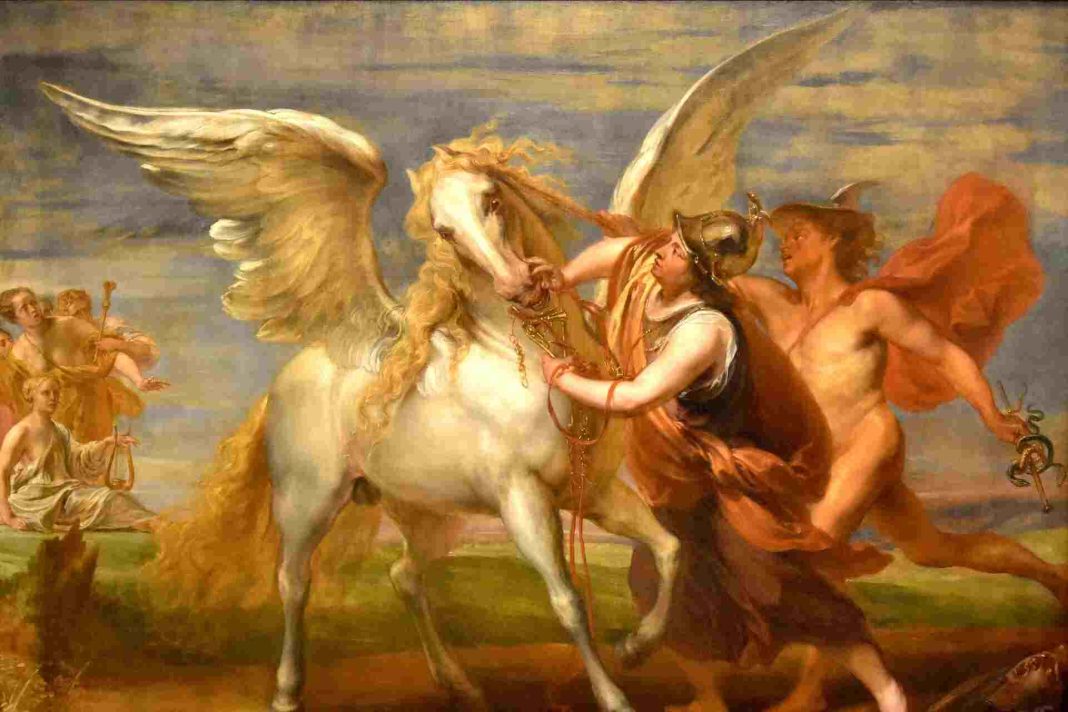The legend of Pegasus, the winged horse, soars through the annals of Greek mythology, captivating the imaginations of generations. From epic tales of heroism to symbolizing poetic inspiration, Pegasus holds a prominent place in ancient Greek lore. This article delves into the origins, significance, and various facets of Pegasus, providing a comprehensive overview for both enthusiasts and curious minds.
The Birth and Origins of Pegasus
Pegasus’ story begins in the dim, dramatic heart of Greek mythology, a world where gods and mortals, heroes and monsters, often collide. The winged horse’s birth is as extraordinary as his life. According to ancient myth, Pegasus emerged from the blood of Medusa, a Gorgon with snakes for hair, when she was slain by the hero Perseus. This moment marks one of the most significant and visually striking events in Greek mythological history.
Perseus, son of Zeus, was tasked with beheading Medusa, whose gaze could turn anyone to stone. Armed with divine gifts, including a reflective shield from Athena and a harpe (sickle-shaped sword) from Hermes, Perseus embarked on his perilous mission. Upon finding Medusa, he used the shield to view her reflection and avoid her deadly gaze. With one swift strike, he severed her head. As Medusa’s blood mingled with the sea foam, Pegasus and his brother, Chrysaor, sprang forth. This miraculous birth symbolizes the fusion of death and creation, chaos, and order.
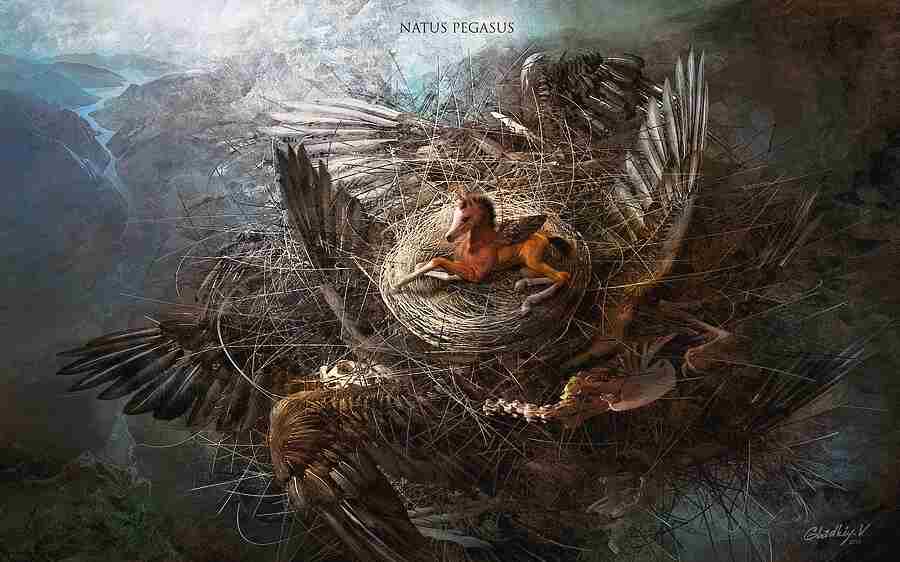
Pegasus, unlike other mythological creatures, held a unique and immediate significance. His emergence was not just a birth but a divine event that connected the mortal and immortal realms. The winged horse’s ethereal nature is evident in his very first moments. As soon as he was born, Pegasus soared into the heavens, marking his domain as both the earth and the sky, a bridge between the human and the divine.
Pegasus’ early associations with the gods further cemented his importance. After his birth, he was taken to Mount Olympus, where he served Zeus, the king of the gods. Pegasus carried Zeus’s thunderbolts, becoming a symbol of divine strength and swiftness. This relationship with Zeus not only elevated Pegasus’ status but also integrated him deeply into the fabric of Greek mythology.
The symbolic aspects of Pegasus are as captivating as his origin story. In Greek culture, he came to represent much more than just a mythological creature. Pegasus embodied the ideals of freedom and inspiration, his wings a metaphor for the boundless creative spirit. This symbolism was particularly embraced by poets, who saw Pegasus as a muse, a source of inspiration that elevated their work to new heights. The Hippocrene spring, believed to have been created by Pegasus striking a rock with his hoof, became a fabled source of poetic inspiration, further linking the winged horse to the arts.
In understanding Pegasus’ origins, one gains insight into the broader themes of Greek mythology: the interplay of divine intervention, the blending of human and supernatural, and the powerful symbols that continue to resonate through time. Pegasus’ story is not just a tale of a miraculous birth but a rich tapestry of meanings that have transcended the ages.
Pegasus in Greek Myths and Legends
Pegasus, the winged horse of Greek mythology, is intricately woven into the tales of gods and heroes, playing a pivotal role in several legendary narratives. One of the most notable stories involving Pegasus is his association with Bellerophon, a Corinthian hero known for his strength and bravery. The myth of Bellerophon and Pegasus begins with a quest that seemed impossible: to slay the monstrous Chimera.
The Chimera was a fearsome creature, part lion, part goat, and part serpent, terrorizing the land of Lycia. To defeat such a beast, Bellerophon needed more than just courage; he needed divine assistance. Enter Pegasus. According to the myth, Bellerophon received guidance from the goddess Athena, who provided him with a golden bridle to tame Pegasus. With this divine tool, Bellerophon was able to capture the winged horse and gain his trust, forging a bond that would be critical to his success.

With Pegasus as his steed, Bellerophon took to the skies, gaining a strategic advantage over the Chimera. From above, he rained down arrows upon the beast, ultimately defeating it and proving his heroism. This legendary partnership not only underscored the importance of Pegasus in Greek mythology but also highlighted the interplay between human valor and divine intervention. Bellerophon’s victory was not merely a personal triumph but a testament to the favor of the gods, embodied in the majestic Pegasus.
Following the Chimera’s defeat, Bellerophon’s ambitions grew. He sought to ascend to Mount Olympus, the home of the gods. Riding Pegasus, he attempted to reach the divine realm, an act of hubris that did not go unpunished. Zeus, angered by Bellerophon’s audacity, sent a gadfly to sting Pegasus, causing the winged horse to buck and throw Bellerophon back to Earth. This fall from grace served as a powerful reminder of the limits of human ambition and the dangers of overreaching.
Pegasus, however, was spared Zeus’s wrath. The winged horse continued to serve the gods, particularly Zeus, for whom he carried thunderbolts. His presence on Mount Olympus solidified his status as a creature of immense power and significance. Pegasus became a symbol of the divine, a reminder of the gods’ omnipotence and their ability to influence the mortal world.
Other legends and myths further enrich Pegasus’ narrative. One such tale involves the creation of the Hippocrene spring. According to the myth, Pegasus struck a rock with his hoof on Mount Helicon, causing a spring to gush forth. This spring, named Hippocrene, or “Horse’s Fountain,” was believed to be a source of inspiration for poets. The waters of Hippocrene were said to imbue those who drank from it with poetic genius, further cementing Pegasus’ role as a muse and a symbol of artistic inspiration.
Through these myths and legends, Pegasus emerges not just as a fantastical creature but as a complex symbol of divine favor, heroic endeavor, and artistic inspiration. His stories reflect the values and beliefs of ancient Greek culture, illustrating the profound connections between humans, heroes, and the gods.
The Symbolism and Powers of Pegasus
Pegasus, the winged horse, is not merely a character from Greek mythology; he embodies a wealth of symbolism and supernatural abilities that have intrigued scholars and enthusiasts for centuries. From his divine origins to his role as a muse, Pegasus stands as a potent symbol in the mythological tapestry.
One of Pegasus’ most renowned powers is his ability to fly. This gift, granted by his divine birth, symbolizes freedom and transcendence. In ancient Greece, flight was associated with the gods and their dominion over the heavens, making Pegasus a direct link between the earthly and the celestial realms. His wings represent the aspiration to rise above the mundane and reach the divine, a concept that resonated deeply with the Greeks’ spiritual and philosophical pursuits.
Pegasus also possessed the remarkable ability to create springs wherever his hooves touched the ground. The most famous of these is the Hippocrene spring on Mount Helicon. According to legend, Pegasus struck a rock with his hoof, and from this impact, the spring burst forth. The waters of Hippocrene were believed to inspire poets, making Pegasus a symbol of poetic and artistic inspiration. This connection to the arts further elevated Pegasus from a mere mythical creature to a muse for creativity and expression.
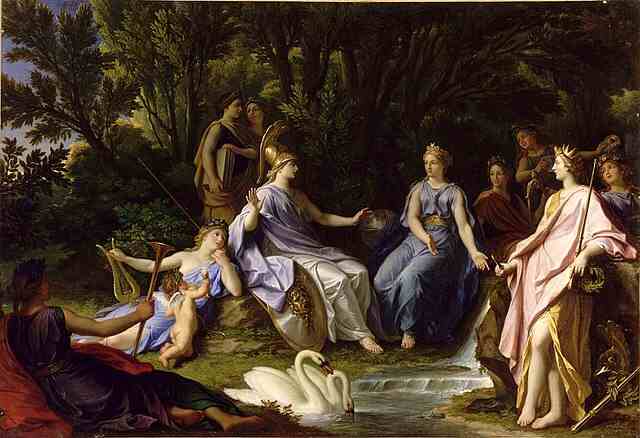
The symbolism of Pegasus extends to his role in various myths. In the story of Bellerophon, Pegasus’ ability to fly allowed the hero to defeat the Chimera, a monstrous creature that terrorized the land. This victory was not just a physical triumph but also a symbolic one, representing the triumph of order over chaos, of human ingenuity aided by divine support. Bellerophon’s successful taming of Pegasus also symbolizes the harmonious relationship between human ambition and divine will, a recurrent theme in Greek mythology.
Pegasus’ connection to Zeus, the king of the gods, further emphasizes his divine nature. After Bellerophon’s fall from grace, Pegasus continued to serve Zeus by carrying his thunderbolts. This service underscores Pegasus’ role as an intermediary between the gods and the mortal world, a bearer of divine power and authority. It also highlights the duality of Pegasus’ nature: while he aids heroes like Bellerophon, he ultimately remains loyal to the gods, reinforcing the notion of divine supremacy.
Beyond his mythological functions, Pegasus has also been interpreted as a symbol of purity and nobility. His white color, often described in myths, reinforces these qualities. In a world where many mythical creatures were fearsome and monstrous, Pegasus stood out as a creature of beauty and grace. The Sphinx from Greek mythology is another fascinating creature that shares similarities with Pegasus in terms of its symbolic significance and role in ancient stories. This distinction made him an ideal symbol for various positive attributes, from artistic inspiration to heroic endeavor.
Pegasus’ symbolism is not confined to ancient Greece. Over the centuries, he has been adopted by various cultures and movements as an emblem of freedom, inspiration, and aspiration. In modern times, Pegasus continues to inspire, appearing in literature, art, and even corporate logos, a testament to his enduring legacy.
Understanding the symbolism and powers of Pegasus provides a deeper insight into the values and beliefs of ancient Greek culture. Through the lens of this winged horse, we see a civilization’s yearning for transcendence, creativity, and connection with the divine. Pegasus, with his soaring flights and life-giving springs, encapsulates these ideals in a form that has captured human imagination for millennia.
Frequently Asked Questions (FAQs)
1. What is a Pegasus in Greek mythology?
Pegasus is a winged horse in Greek mythology, born from the blood of the Gorgon Medusa when she was slain by the hero Perseus. Pegasus symbolizes freedom, divine inspiration, and the connection between the mortal and divine worlds.
2. Who created Pegasus in Greek mythology?
Pegasus was created from the blood of Medusa, a Gorgon whose gaze could turn anyone to stone. When Perseus beheaded Medusa, Pegasus sprang forth from her blood, making his creation a unique event in Greek mythology.
3. Who rides Pegasus in Greek mythology?
Bellerophon, a Corinthian hero, is the most famous rider of Pegasus. With the help of a golden bridle given by the goddess Athena, Bellerophon tamed Pegasus and used his ability to fly to defeat the Chimera.
4. What does Pegasus represent in Greek mythology?
Pegasus represents several ideals in Greek mythology, including freedom, inspiration, and the divine. His ability to fly symbolizes the aspiration to rise above earthly constraints, and his creation of the Hippocrene spring links him to poetic inspiration.
5. Why is Pegasus important in Greek mythology?
Pegasus is important in Greek mythology because of his unique birth, his role in aiding heroes like Bellerophon, and his association with the gods, particularly Zeus. He embodies the connection between the human and divine, and his symbolism extends to themes of artistic inspiration and heroic endeavor.
Depictions of Pegasus in Art and Literature
The figure of Pegasus has transcended its mythological origins to become a central motif in Greek art and literature, capturing the imagination of artists and writers through the ages. The artistic representations of Pegasus are as varied as they are numerous, reflecting the evolving cultural and symbolic significance of this winged horse.
In ancient Greek art, Pegasus first appeared in pottery and sculpture. Early depictions often showed Pegasus alongside Bellerophon, highlighting their legendary partnership. These images were not just artistic expressions but also conveyed moral and heroic ideals. On vases and amphorae, Pegasus is frequently depicted in dynamic motion, wings spread wide, capturing the sense of speed and divine power associated with his myth. Sculptures from the Archaic and Classical periods often present Pegasus in mid-flight, a testament to the fascination with his ability to transcend the earthly plane.
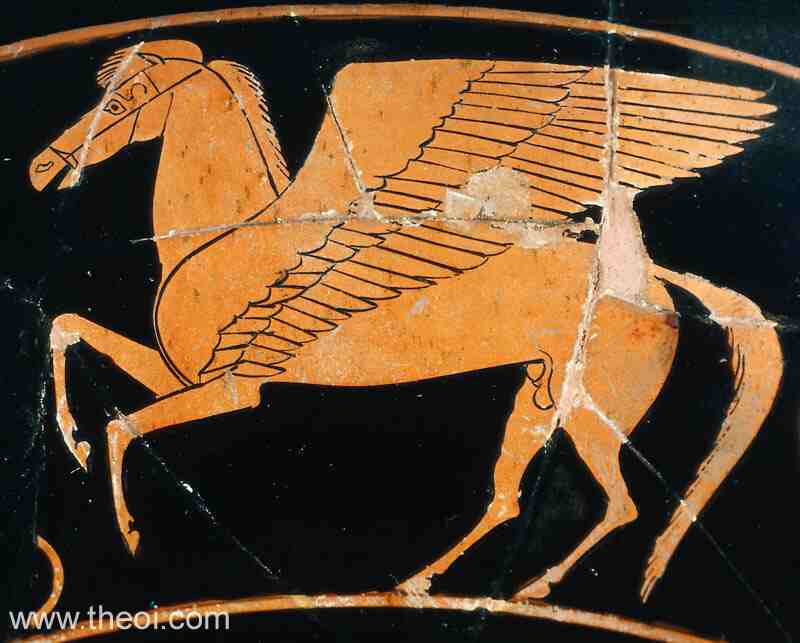
As Greek art evolved, so did the portrayal of Pegasus. During the Hellenistic period, more detailed and expressive representations emerged. Artists began to explore the emotional and symbolic dimensions of Pegasus, emphasizing his role as a muse and a symbol of inspiration. This era saw Pegasus depicted in more naturalistic styles, with intricate details that highlighted his grace and beauty. The artistic focus shifted from mere representation to a deeper exploration of the mythological themes Pegasus embodied.
In literature, Pegasus’ impact was equally profound. He features prominently in the works of ancient poets such as Hesiod and Pindar, who celebrated his birth and his association with the Muses. Hesiod’s “Theogony” recounts the origin of Pegasus and his creation of the Hippocrene spring, linking the winged horse directly to poetic inspiration. Pindar’s odes often invoked Pegasus as a symbol of the creative and transcendent power of poetry, reinforcing his status as a divine muse.
Roman literature also embraced Pegasus, integrating him into their own mythological framework. Ovid’s “Metamorphoses,” a cornerstone of Roman mythology, recounts the tale of Pegasus and Bellerophon, ensuring that the legend continued to inspire long after the decline of Greek civilization. The adoption of Pegasus by Roman poets and artists demonstrates the enduring appeal of his story and the universal themes of aspiration and inspiration he represents.
Moving into the Renaissance, Pegasus saw a revival in European art and literature. The winged horse became a popular subject in the works of Renaissance artists, who were inspired by classical antiquity. Paintings and sculptures from this period often depicted Pegasus in scenes of mythological grandeur, emphasizing his beauty and symbolic power. Renaissance poets, too, drew upon the legend of Pegasus to explore themes of artistic inspiration and the divine nature of creativity.
In modern times, Pegasus continues to be a powerful symbol. He appears in contemporary literature and fantasy genres, embodying ideals of freedom and adventure. Pegasus is also a popular figure in children’s literature, where his story is often adapted to inspire young readers. The enduring legacy of Pegasus in art and literature highlights the timeless nature of his myth, a testament to the power of storytelling and the human imagination.
Through these artistic and literary depictions, Pegasus has transcended his mythological roots to become a universal symbol of inspiration, creativity, and aspiration. His presence in art and literature across different cultures and eras underscores the profound impact of myth on human culture and the enduring allure of the stories we tell about our origins, our dreams, and our quest for transcendence.
Pegasus in Modern Culture and Fantasy
The legacy of Pegasus extends far beyond ancient Greece, permeating modern culture and fantasy with a richness that reflects the timeless appeal of this mythological creature. From literature and art to film and video games, Pegasus continues to inspire and captivate audiences worldwide.
In contemporary literature, Pegasus often appears as a symbol of freedom and otherworldly beauty. He has been reimagined in various genres, from fantasy novels to children’s books. One notable example is Rick Riordan’s “Percy Jackson & the Olympians” series, where Pegasus and other mythological beings are integrated into a modern-day setting. In these stories, Pegasus is not just a mythical relic but a living, breathing character that interacts with the protagonists, bringing ancient myths to life for a new generation of readers.
The visual representation of Pegasus has also evolved with modern art. Artists today continue to draw inspiration from the winged horse, creating works that range from realistic paintings to abstract interpretations. These depictions often explore new dimensions of Pegasus’ symbolism, reflecting contemporary themes such as liberation, transcendence, and the fusion of human and divine. Street art and digital art platforms have embraced Pegasus as a motif, allowing the myth to reach diverse and global audiences.
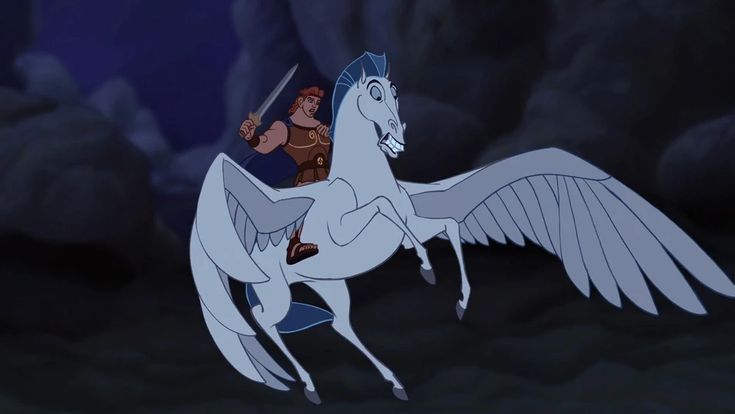
Cinema and television have further popularized Pegasus, embedding him in the visual lexicon of modern fantasy. Films such as Disney’s “Hercules” introduce Pegasus to younger audiences, portraying him as a loyal and heroic companion. This version of Pegasus is imbued with a personality that resonates with viewers, making the myth accessible and engaging. Additionally, television series like “Xena: Warrior Princess” and “Clash of the Titans” have featured Pegasus, reinforcing his role in the broader tapestry of Greek mythology within popular culture.
The digital age has also seen Pegasus soar into the realm of video games. In titles like “Minecraft,” where creativity and exploration are key elements, Pegasus can be summoned and ridden, enhancing the player’s experience and connecting the ancient myth with modern interactive entertainment. The “Greek Fantasy Mod” in Minecraft, for instance, allows players to tame and ride Pegasus, bridging the gap between ancient lore and contemporary gaming culture.
Moreover, Pegasus has found a place in branding and corporate imagery. Companies across various industries use Pegasus as a logo or symbol, capitalizing on his associations with speed, agility, and inspiration. This commercial use underscores the enduring appeal of Pegasus, highlighting his versatility as a symbol that transcends cultural and temporal boundaries.
In modern fantasy literature, Pegasus often symbolizes the quest for knowledge and the journey into the unknown. He represents the boundless potential of human imagination and the aspiration to transcend earthly limits. Writers and artists draw on these themes to create works that resonate with contemporary audiences, who see in Pegasus a reflection of their own dreams and desires.
The continuing relevance of Pegasus in modern culture is a testament to the enduring power of myth. His story, rich with symbolism and historical depth, continues to inspire creativity and exploration. As new generations encounter Pegasus through various media, the mythological horse’s legacy grows, adapting to the changing landscapes of culture and technology. Through literature, art, film, and digital media, Pegasus remains a timeless figure, a bridge between the ancient past and the ever-evolving present.
Use of Our Content
⚠️ Content on “Mystery Uncover” is protected under US and International Copyright Laws.
You are free to reuse, republish, and share our content by giving credit to the source as Mystery Uncover with a link to the original material on mysteryuncover.com.


